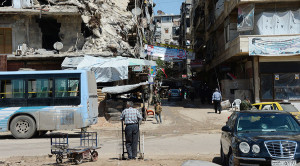 In its heyday during the mid-2000s, it was the Save Darfur campaign. A few years later, it was the Kony 2012 campaign. Today, we have the #AleppoIsBurning campaign. Like its predecessors, #AleppoIsBurning claims to be aimed at ending a humanitarian crisis through the mechanism of Western intervention, only this time not in the Sudan or in Uganda, but in Syria.
In its heyday during the mid-2000s, it was the Save Darfur campaign. A few years later, it was the Kony 2012 campaign. Today, we have the #AleppoIsBurning campaign. Like its predecessors, #AleppoIsBurning claims to be aimed at ending a humanitarian crisis through the mechanism of Western intervention, only this time not in the Sudan or in Uganda, but in Syria.
The power of social media is immense. With the Syrian army winning battlefront victories in Aleppo (Syria’s most populated city prior to the civil war) against anti-government rebels like ISIS, the Al Qaeda-linked Al-Nusra Front and the U.S.-backed “Free Syrian Army,” Obama has quintupled the number of special operations forces deployed to Syria. At the same time, social media-driven campaigns for increased Western “humanitarian” intervention have come to life on Facebook and Twitter.
Latest “humanitarian” interventionist fad
#AleppoIsBurning, a campaign begun on Facebook by the Syria Pressure Advocacy Group (SPAG), asked followers to change their profile picture to a red square and to join a “global protest” to “condemn the war crimes against humanity of the Assad regime and its allies” and to support “action” from the “international community.”
Like similar campaigns, it substitutes much-needed knowledge and information with accusations founded on distortions. For example, the campaign’s Facebook page suggests that all recent civilian deaths in Aleppo due to fighting are at the hands of the “Syrian regime,” when in reality 71 civilians, including 13 children, were killed in the last week of April from anti-government rebel shelling.
The #AleppoIsBurning call-to-action demands that the “international community” hold the “Assad regime” accountable for the destruction of a medical facility on April 20, but doesn’t utter a single word about the 33 hospitals put out of service by rebel attacks on government-controlled territory, which have deprived hundreds of thousands of Syrians health services.
#AleppoIsBurning is not a peace movement but war mobilization
This misleading and misinformed presentation reveals that while #AleppoIsBurning campaign purports to be innocently concerned with the general suffering of the Syrian people, it is in reality designed to build support for an imperialist agenda.
Its mission is to establish in the public mind that violence in Aleppo (and all of Syria) is one where the evil Syrian “regime” perpetrates geometrically mounting atrocities against the helpless Syrian “people.”
It has packaged Syria for a Western audience as a world populated by villains and victims. The perpetrators are so evil and victims are so helpless that the only possibility of relief is a rescue mission from the outside, preferably in the form of a Western-led military intervention. Indeed, the press release issued by the organizers of the #AleppoIsBurning campaign states that “we will not stop… until the International community intervenes and saves them [the Syrian people].”
This narrative fits in seamlessly with the Washington narrative shamefully repeated in the corporate-owned media. In this way, #AleppoIsBurning has become an indistinguishable twin of the demonization campaign that accompanies all Western military interventions, whether in the former Yugoslavia, Iraq or Libya.
Pro-interventionist cries to “protect civilians” were used by Western imperialists as a pretext to overthrow the Libyan state in 2011, with disastrous consequences for Libyans.
Misleading public and confusing antiwar movement
The regime-versus-the-people narrative propagated by Western governments and the corporate media also emphasizes and distorts the ethno-sectarian dimension to the conflict. There is a widespread assumption that the anti-government rebellion represents all of Syria’s Sunni majority (74% of the population) against the sectarian rule of the Alawite minority (12 percent). This has become conventional wisdom in Western media. The universally ignored reality is that most of the officers and soldiers in the Syrian army and most government officials, including ministers and diplomats, are Sunni. Despite some early desertions, the government and the military have retained a pluralistic character and held together in spite of the extreme difficulty of fighting on several fronts.
The results of the April 13 Syrian parliamentary elections are a striking case-in-point. Sunni representatives completely dominate the new assembly.
Eighty percent of the population lives in the government controlled territory and was able to participate in the elections. Of 250 parliamentary seats up for grabs, 186 members of the new government are reportedly Sunni, compared with only 21 Alawite. In other words, the outcome is reflective of the religious affiliations of the geographic areas taking part in the voting process. This does not conform to the mass media presentation of an Alawite minority ruling the country in a totalitarian manner.
To the contrary, it points to the fact that large numbers of Syrians still see themselves primarily as Syrians, defending the Syrian state, and that sectarian identities such as Sunni, Alawite, Shia, Christian or Druz are often secondary.
The #AleppoIsBurning publicity campaign’s arrogant and reckless call for Western intervention is dangerous at a time when the prospect of incremental increases in U.S. forces in Syria are on the horizon. The campaign’s call for “justice” is really a slogan that masks a drive toward even more hawkish policies of aggression.





